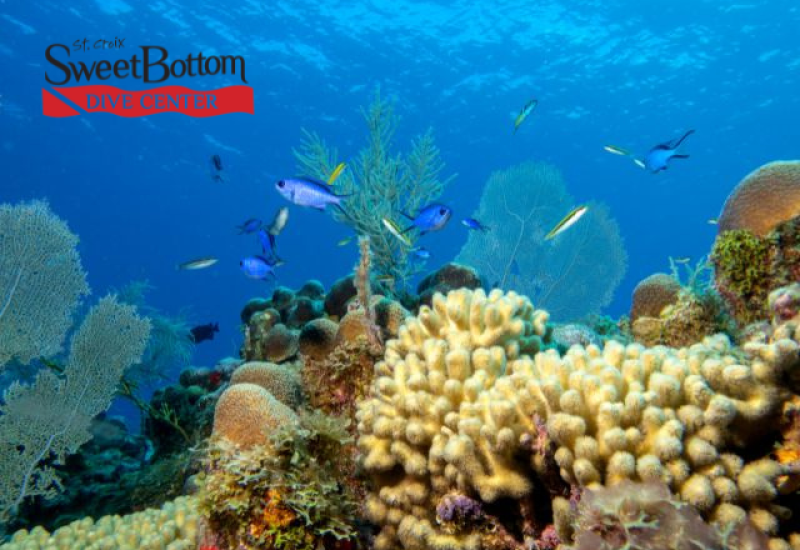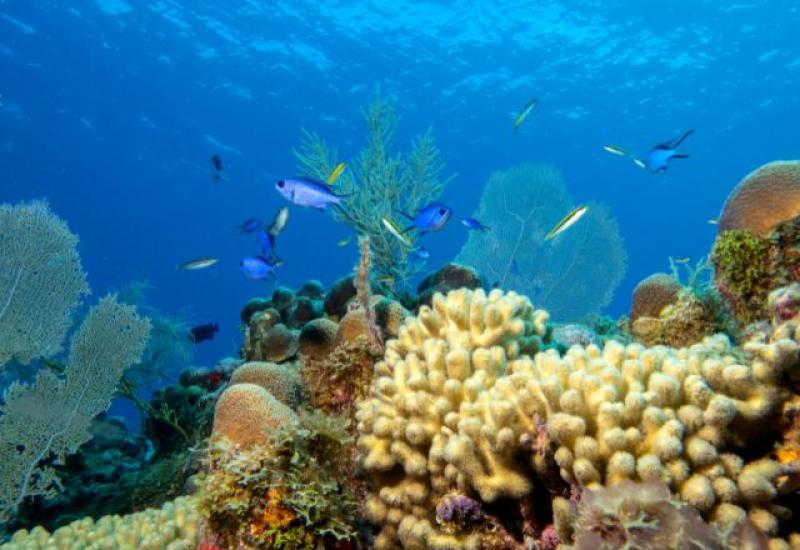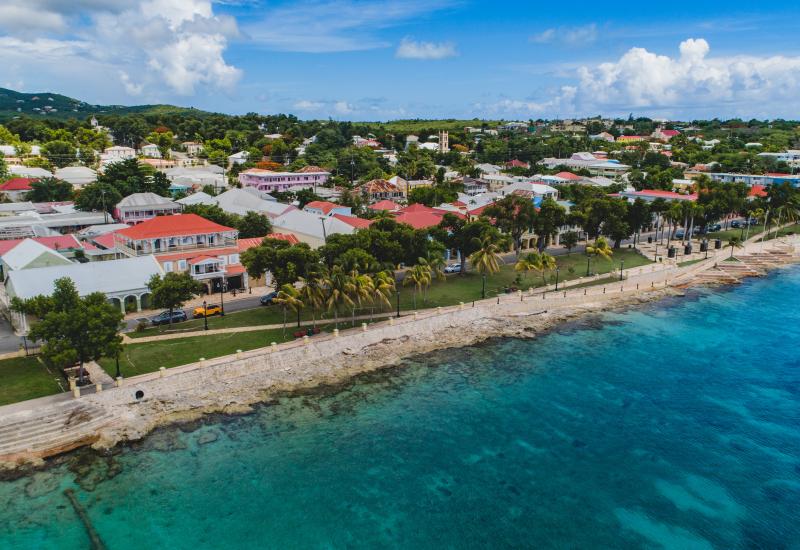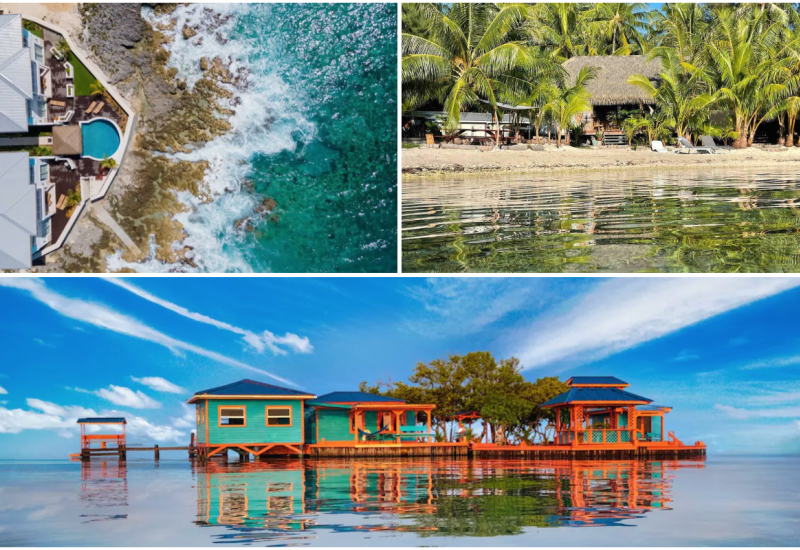Island-Hopping In The U.S. Virgin Islands

Trunk Bay, St John, United States Virgin Islands.
The U.S. Virgin Islands are a brilliant mix of land and water, spiny volcanic mountains rising above jagged coastlines with cobalt and turquoise seas swirling between them like threads of an Oriental rug. The three main Virgins — St. Croix, St. Thomas and St. John — are about as close to a foreign country as you can get without leaving U.S. waters, and they attract plenty of expats. During my recent visit, I found the Virgins to be full of happy exiles, who most likely chose these islands for the same reason that led Columbus to call them Las Once Mil Virgenes: their pristine beauty, above water and below. As the story goes, when Columbus first sighted this collection of islands, islets and rocky cays in 1493, their splendor reminded him of the legend of Saint Ursula and her 11,000 beautiful virgins. Much has changed since then, to be sure, and the Virgins have grown into bustling ports, communities and vacation destinations. But the USVIs still offer one of the most scenic and unspoiled parks in the world, on St. John, and a thrilling underwater wilderness of great diversity.
St. Thomas
I began my adventure on St. Thomas, the bustling cruise ship capital of the Caribbean, with a dive on the Miss Opportunity, a 300-plus-foot vessel that lies at a depth of 55 feet. Entering through a hole in the stern, I saw what appeared to be an operating table covered in silt, with big-eyed squirrelfish peering from the shadows, and a strangely placed pile of tires and flotsam. Like many of the wrecks in these waters, this ship comes with a good backstory: During World War II it functioned as a hospital barge, then became government offices, then a nautical nuisance after a torrential rain kicked it loose. A contractor was supposed to tow it out to the 3,000-foot trench that carves a scythe through this part of the Caribbean, but, contractors being contractors, the ship was scuttled close to shore with a load of paid-for garbage, hence the tires. Soon fishermen were reporting excellent catches where little had swum before. Divers guessed structure.
We exited the spacious holds and doubled back to the dive boat along the hull, which is encrusted with orange hydroids and occasional fire worms that look like bright centipedes and sting if you put them in your mouth. (Don't do that.)
St. Thomas is awash in other interesting wrecks, too, such as the Major General Rogers and the WIT Shoal II. There's also no shortage of fishy reefs and dramatic rock formations here, as well as easy access to the reefs in Pillsbury Sound, which are also diveable from St. John.
St. John
From St. Thomas, I took the sunny little ferry over to St. John, where life is lived in pleasant slo-mo, the denizens a mix of polite hippies mixed with Wall Street types who have buried their Blackberries. St. John is the smallest of the three main U.S. Virgins, but is the most unspoiled, thanks to the Virgin Islands National Park, which covers two-thirds of the island. Diving takes place primarily off the southeast and east sides of the island, with the shallow coral reefs in sheltered Pillsbury Sound the most popular, since they're easily accessed by operators from both St. John and St. Thomas.
I spent a surface interval snorkeling in Trunk Bay before rocketing off on a jeep adventure over the precipitous mountain road. Night was falling, and the rain came in cloudy spurts. Each time, a cacophony of rainforest frogs would burst into mating song, and then the rain would be gone, and the misty silence wonderful. Such is St. John, drenched with natural wonders.
St. Croix
St. Croix is distinctly different from the lost-in-time nature preserve that is St. John and the business and tourist capital that is St. Thomas. At 80 square miles, St. Croix is larger than the others, slightly more populous, and perhaps funkier, fitted with a major oil refinery and a varied topside culture. But underwater, St. Croix offers some of the best scenery in the Virgins, with seahorses on the night dive at the Frederiksted Pier and walls galore, the most famous being Salt River Canyon, which drops precipitously into the 13,000-foot abyss.
I was there close to hurricane season, so we stayed close to Christiansted Harbor, where I dived Scotch Bank and Eagle Ray. Scotch Bank features eagle rays and stingrays, while Eagle Ray has no rays but lots of turtles sleeping in crevices 40 feet down. Though I saw plenty of marine creatures of all kinds, for me the showcase species on St. Croix were the sponges, honking big orange elephant ear sponges, stove-pipe and barrel sponges, which looked like giant psychedelic tennis shoes growing on the bottom.
I spent nearly a week diving these islands and found it easy and pleasant to travel between them. Commuter seaplanes are the perfect way to island-hop--they ease into the warm current and taxi like a tarpon to the dock--and I grew to enjoy the slow, rumbling zoom of the unbuffered engines. Just be sure to tell the pilot you've been diving, and he'll stay below 1,000 feet, where the view of the 11,000 Virgins is even better.
Top 12 Dives
St. Thomas
FrenchCap Cay An uninhabited island six miles south of St. Thomas, Frenchcap offers caves, ledges, canyons and a beautiful swim-through. Expect everything from hogfish to lobster at depths between 35 and 90 feet.
Major General Rogers This ex-Coast Guard buoy tender, at a depth of 65 feet in Pillsbury Sound, features lavish growth and frequent sightings of hogfish, barracuda and snapper.
Sail Rock Soaring some 125 feet out of the water, this spectacular rock formation sits above three seamounts that drop to 90 feet below. An advanced dive, due to strong currents.
WIT Shoal II This 328-foot-long freighter of the West Indian Trading Company features cup corals, grouper, barracuda and lush sea fans and sponges in 90 feet of water.
St. John
Booby Rock Off the southeast coast, this ledge system houses lobsters, nurse sharks, nudibranchs, sea slugs and coral crabs at depths between 15 and 50 feet.
Carval Rock This rock formation attracts turtles, tarpon, eels and nurse sharks and features a lush coral forest. Action all the way from 20 to 80 feet. Currents can be tricky, making it an advanced dive.
Congo North Three miles northwest of St. John, this seldom done drift dive on the backside of Congo Cay features soft coral beds with dramatic rock architecture at depths of 25 to 85 feet.
Eagle Shoal Expect honeycombed caves and dramatic lighting at this unsheltered, condition-dependent dive site off Coral Bay on the southeast coast.
St. Croix
Cane Bay Wall This popular wall — which plunges over 2,000 feet — is accessible from the beach as well as by boat. Expect lush corals, tropicals and pelagics out in the blue.
Jimmy's Surprise This large seamount off the island's north shore rises to within 55 feet of the surface. Covered with a forest of sea fans, it attracts grouper, sharks, jacks and the occasional hammerhead.
North Star Vivid sponges, gorgonians, turtles, jacks and reef sharks make their home along this drop-off, which starts at 25 feet and plunges to 2,000.
Salt River Canyon The dramatic Salt River Canyon is separated into two walls by a deep chasm. Expect grouper, snapper and jacks along the East Wall. The sheer, textured West Wall begins at 30 feet and offers canyons, swim-throughs and crevices.
InDepth
Water Conditions: Water temperatures range from the upper 70s in winter to mid-80s in summer. Visibility ranges from 50 to 100 feet.
Weather: Air temps range from the low to high 80s year-round.
For More Info: U.S. Virgin Islands Tourism.
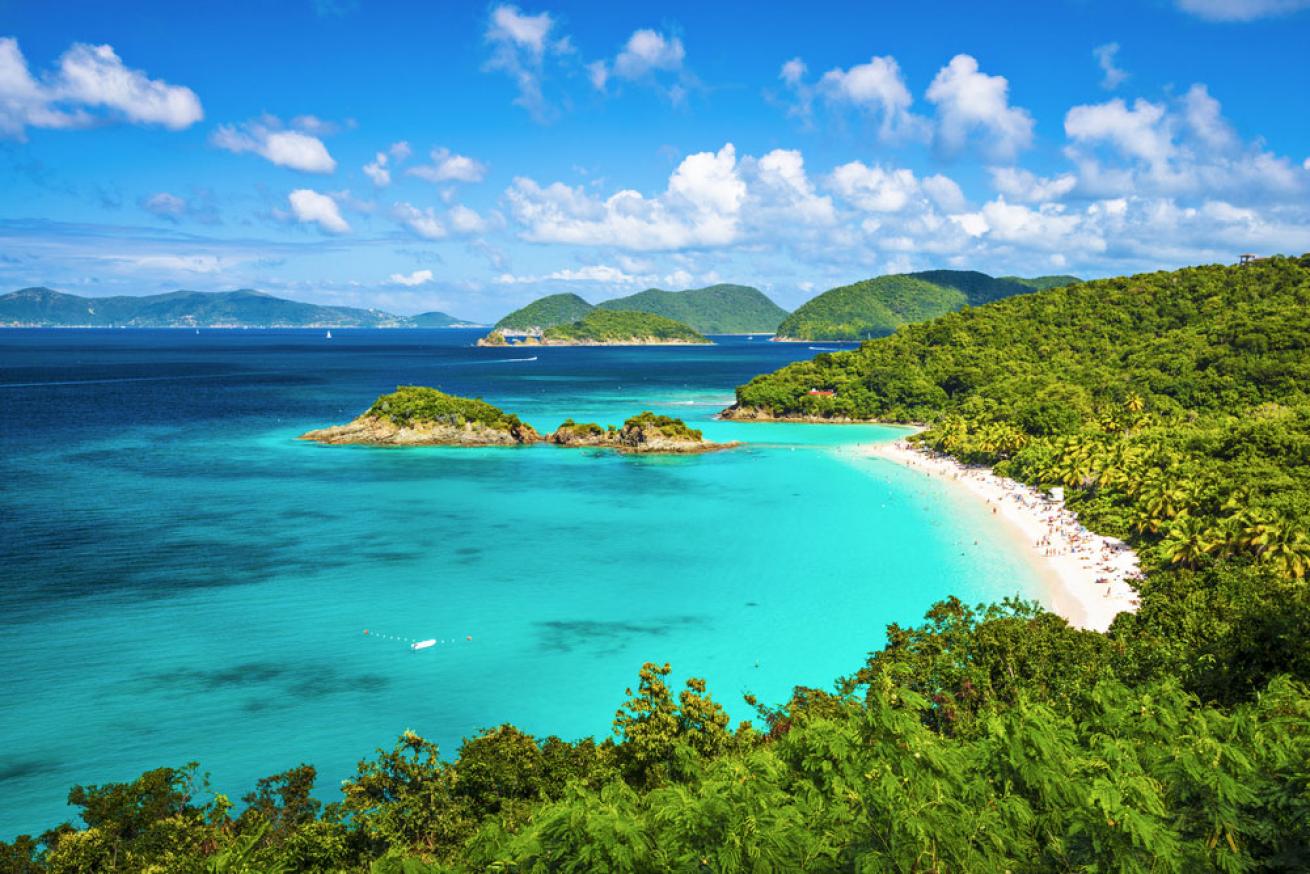
Trunk Bay, St John, United States Virgin Islands.
The U.S. Virgin Islands are a brilliant mix of land and water, spiny volcanic mountains rising above jagged coastlines with cobalt and turquoise seas swirling between them like threads of an Oriental rug. The three main Virgins — St. Croix, St. Thomas and St. John — are about as close to a foreign country as you can get without leaving U.S. waters, and they attract plenty of expats. During my recent visit, I found the Virgins to be full of happy exiles, who most likely chose these islands for the same reason that led Columbus to call them Las Once Mil Virgenes: their pristine beauty, above water and below. As the story goes, when Columbus first sighted this collection of islands, islets and rocky cays in 1493, their splendor reminded him of the legend of Saint Ursula and her 11,000 beautiful virgins. Much has changed since then, to be sure, and the Virgins have grown into bustling ports, communities and vacation destinations. But the USVIs still offer one of the most scenic and unspoiled parks in the world, on St. John, and a thrilling underwater wilderness of great diversity.
St. Thomas
I began my adventure on St. Thomas, the bustling cruise ship capital of the Caribbean, with a dive on the Miss Opportunity, a 300-plus-foot vessel that lies at a depth of 55 feet. Entering through a hole in the stern, I saw what appeared to be an operating table covered in silt, with big-eyed squirrelfish peering from the shadows, and a strangely placed pile of tires and flotsam. Like many of the wrecks in these waters, this ship comes with a good backstory: During World War II it functioned as a hospital barge, then became government offices, then a nautical nuisance after a torrential rain kicked it loose. A contractor was supposed to tow it out to the 3,000-foot trench that carves a scythe through this part of the Caribbean, but, contractors being contractors, the ship was scuttled close to shore with a load of paid-for garbage, hence the tires. Soon fishermen were reporting excellent catches where little had swum before. Divers guessed structure.
We exited the spacious holds and doubled back to the dive boat along the hull, which is encrusted with orange hydroids and occasional fire worms that look like bright centipedes and sting if you put them in your mouth. (Don't do that.)
St. Thomas is awash in other interesting wrecks, too, such as the Major General Rogers and the WIT Shoal II. There's also no shortage of fishy reefs and dramatic rock formations here, as well as easy access to the reefs in Pillsbury Sound, which are also diveable from St. John.
St. John
From St. Thomas, I took the sunny little ferry over to St. John, where life is lived in pleasant slo-mo, the denizens a mix of polite hippies mixed with Wall Street types who have buried their Blackberries. St. John is the smallest of the three main U.S. Virgins, but is the most unspoiled, thanks to the Virgin Islands National Park, which covers two-thirds of the island. Diving takes place primarily off the southeast and east sides of the island, with the shallow coral reefs in sheltered Pillsbury Sound the most popular, since they're easily accessed by operators from both St. John and St. Thomas.
I spent a surface interval snorkeling in Trunk Bay before rocketing off on a jeep adventure over the precipitous mountain road. Night was falling, and the rain came in cloudy spurts. Each time, a cacophony of rainforest frogs would burst into mating song, and then the rain would be gone, and the misty silence wonderful. Such is St. John, drenched with natural wonders.
St. Croix
St. Croix is distinctly different from the lost-in-time nature preserve that is St. John and the business and tourist capital that is St. Thomas. At 80 square miles, St. Croix is larger than the others, slightly more populous, and perhaps funkier, fitted with a major oil refinery and a varied topside culture. But underwater, St. Croix offers some of the best scenery in the Virgins, with seahorses on the night dive at the Frederiksted Pier and walls galore, the most famous being Salt River Canyon, which drops precipitously into the 13,000-foot abyss.
I was there close to hurricane season, so we stayed close to Christiansted Harbor, where I dived Scotch Bank and Eagle Ray. Scotch Bank features eagle rays and stingrays, while Eagle Ray has no rays but lots of turtles sleeping in crevices 40 feet down. Though I saw plenty of marine creatures of all kinds, for me the showcase species on St. Croix were the sponges, honking big orange elephant ear sponges, stove-pipe and barrel sponges, which looked like giant psychedelic tennis shoes growing on the bottom.
I spent nearly a week diving these islands and found it easy and pleasant to travel between them. Commuter seaplanes are the perfect way to island-hop--they ease into the warm current and taxi like a tarpon to the dock--and I grew to enjoy the slow, rumbling zoom of the unbuffered engines. Just be sure to tell the pilot you've been diving, and he'll stay below 1,000 feet, where the view of the 11,000 Virgins is even better.
Top 12 Dives
St. Thomas
FrenchCap Cay An uninhabited island six miles south of St. Thomas, Frenchcap offers caves, ledges, canyons and a beautiful swim-through. Expect everything from hogfish to lobster at depths between 35 and 90 feet.
Major General Rogers This ex-Coast Guard buoy tender, at a depth of 65 feet in Pillsbury Sound, features lavish growth and frequent sightings of hogfish, barracuda and snapper.
Sail Rock Soaring some 125 feet out of the water, this spectacular rock formation sits above three seamounts that drop to 90 feet below. An advanced dive, due to strong currents.
WIT Shoal II This 328-foot-long freighter of the West Indian Trading Company features cup corals, grouper, barracuda and lush sea fans and sponges in 90 feet of water.
St. John
Booby Rock Off the southeast coast, this ledge system houses lobsters, nurse sharks, nudibranchs, sea slugs and coral crabs at depths between 15 and 50 feet.
Carval Rock This rock formation attracts turtles, tarpon, eels and nurse sharks and features a lush coral forest. Action all the way from 20 to 80 feet. Currents can be tricky, making it an advanced dive.
Congo North Three miles northwest of St. John, this seldom done drift dive on the backside of Congo Cay features soft coral beds with dramatic rock architecture at depths of 25 to 85 feet.
Eagle Shoal Expect honeycombed caves and dramatic lighting at this unsheltered, condition-dependent dive site off Coral Bay on the southeast coast.
St. Croix
Cane Bay Wall This popular wall — which plunges over 2,000 feet — is accessible from the beach as well as by boat. Expect lush corals, tropicals and pelagics out in the blue.
Jimmy's Surprise This large seamount off the island's north shore rises to within 55 feet of the surface. Covered with a forest of sea fans, it attracts grouper, sharks, jacks and the occasional hammerhead.
North Star Vivid sponges, gorgonians, turtles, jacks and reef sharks make their home along this drop-off, which starts at 25 feet and plunges to 2,000.
Salt River Canyon The dramatic Salt River Canyon is separated into two walls by a deep chasm. Expect grouper, snapper and jacks along the East Wall. The sheer, textured West Wall begins at 30 feet and offers canyons, swim-throughs and crevices.
InDepth
Water Conditions: Water temperatures range from the upper 70s in winter to mid-80s in summer. Visibility ranges from 50 to 100 feet.
Weather: Air temps range from the low to high 80s year-round.
For More Info: U.S. Virgin Islands Tourism.

